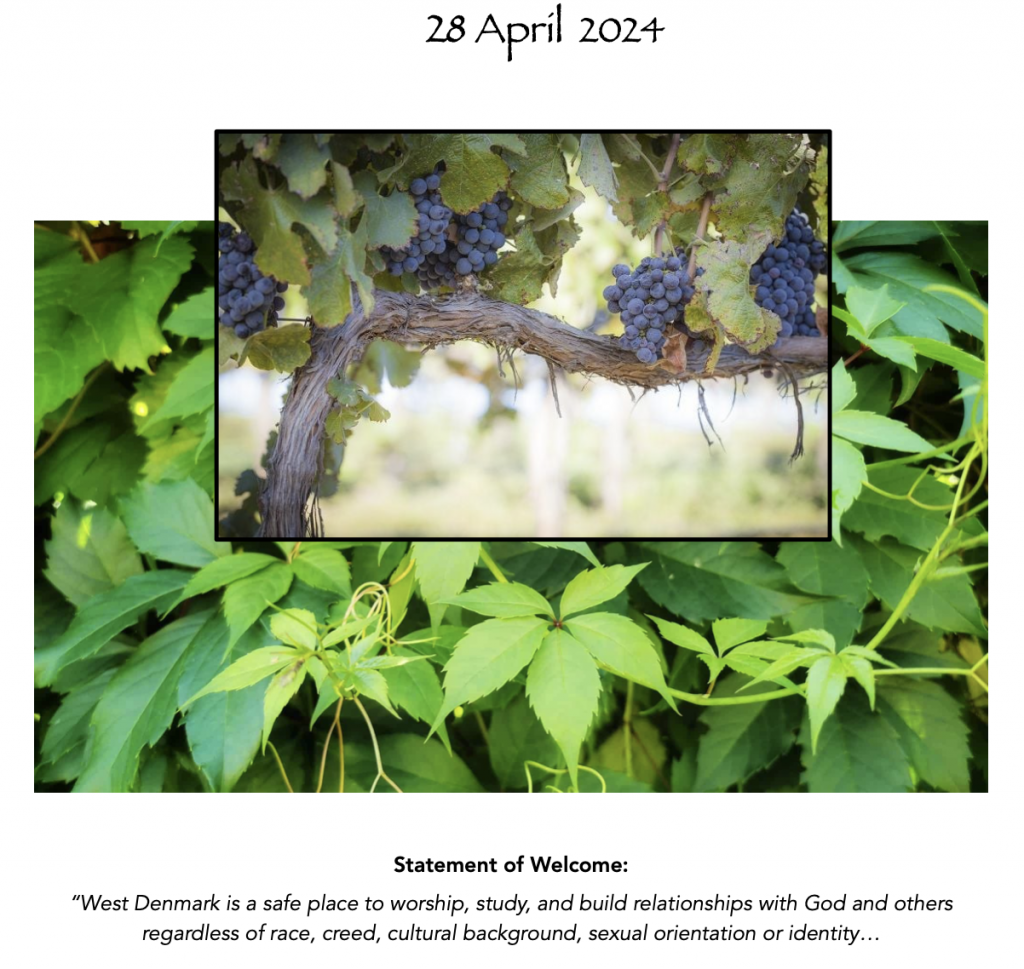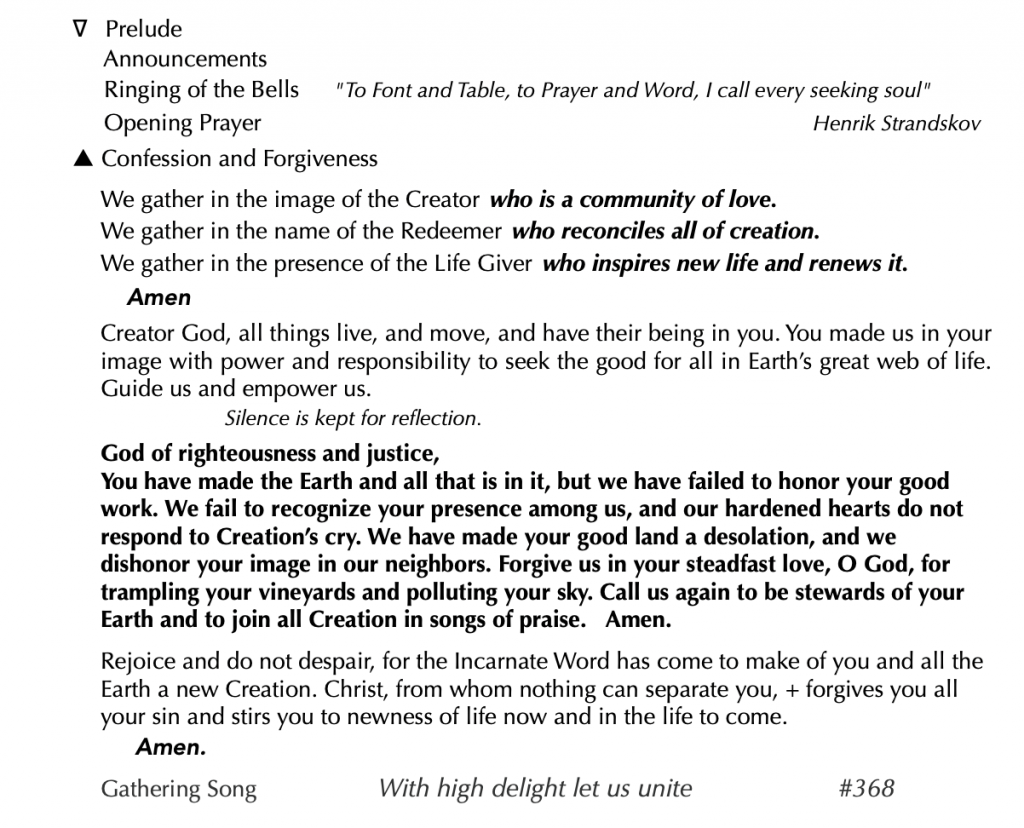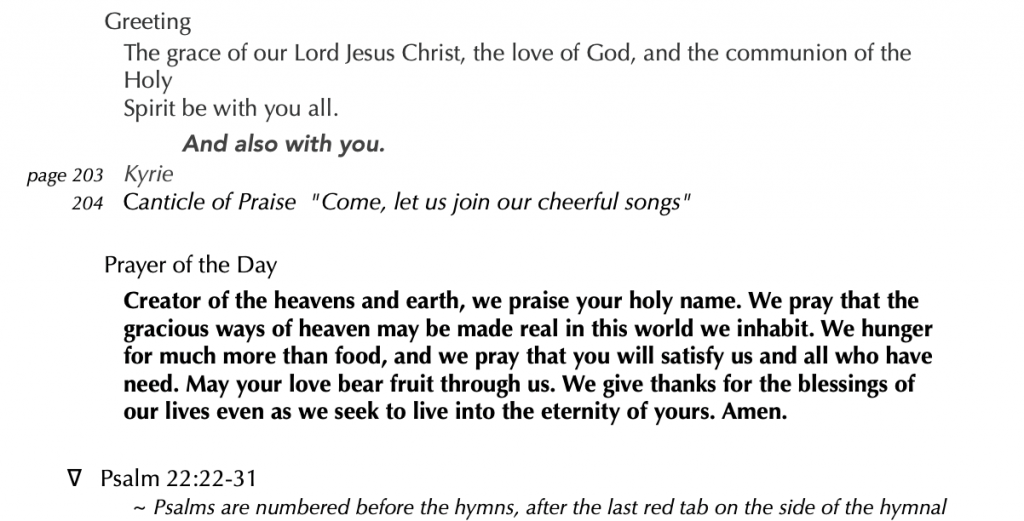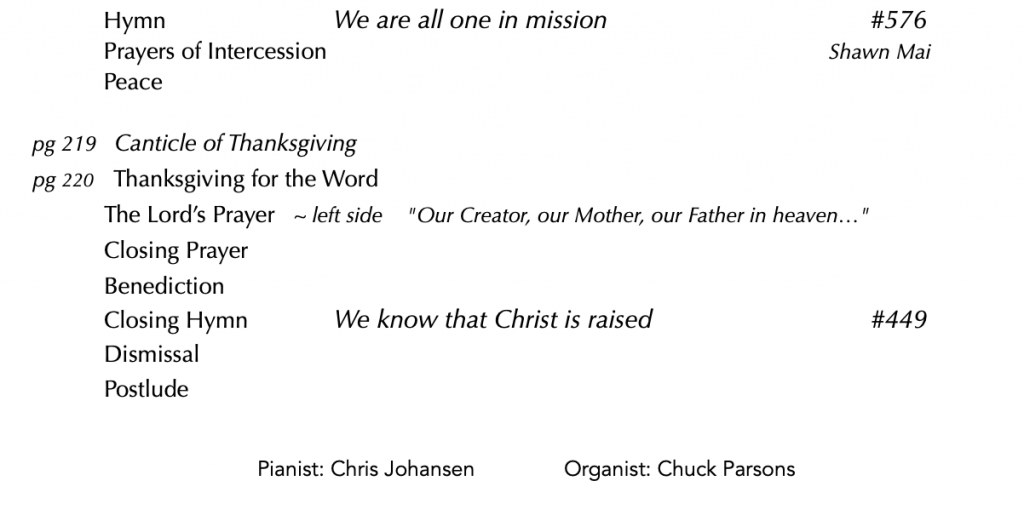


John 15:1-8 “I am the true vine, and my Father is the vine-grower. He removes every branch in me that bears no fruit. Every branch that bears fruit he prunes to make it bear more fruit. You have already been cleansed by the word that I have spoken to you. Abide in me as I abide in you. Just as the branch cannot bear fruit by itself unless it abides in the vine, neither can you unless you abide in me. I am the vine; you are the branches. Those who abide in me and I in them bear much fruit, because apart from me you can do nothing. Whoever does not abide in me is thrown away like a branch and withers; such branches are gathered, thrown into the fire, and burned. If you abide in me and my words abide in you, ask for whatever you wish, and it will be done for you. My Father is glorified by this, that you bear much fruit and become my disciples.”
The gospel of the Lord…………thanks be to God
Hymn: We come to the hungry feast
Some of you may actually know about grape vines – the kind Jesus was talking about – vineyard vines. But, instead, you have to listen to what I know. I know about wild grapes and Virginia creeper. And I kind of like the difference between the official vineyard practices, and the way wild things grow.
Until they needed to be cut down for the parsonage re-siding project, I tended wild grape vines. I suppose it was less tending and more like enabling. I strung clothesline under the eaves, around all three sides of the porch and let them go. Wild grape vines grow fast and branch out and tendril themselves onto everything they can reach – the screens, the clothesline, the hummingbird feeder, the siding of the house whenever they find a little flaw to hang onto. Every fall I cut them back to just the main vine and a few hearty branches, and by mid-summer they filled in the upper third of the porch walls in a thick leafy garland. They provided shelter to bird’s nests and tree frogs. During rain showers, song birds and butterflies tucked in under the natural umbrella, and once the grapes formed our cats were scandalized watching mice climb up in the dark to eat the fruit. Grape vines create their own ecosystem buzzing with life. I don’t understand how tendrils know there is something out there, just beyond their reach to stretch for, but they seem to. Sometimes they end up latching onto a sister tendril and twine themselves together into a rope going nowhere until they catch the tip of a shingle, or maybe an updraft, or the edge of thought. That seems to be all they need.
At our place in Washburn, Virginia creeper is busy creeping through the edge of the field by the driveway and sauna. I know it can climb – trees, buildings, barns, tractors – but ours is mostly content to act as ground cover. I spent the better part of a day last summer pulling it out of the space I’ve designated for a future garden. I picked up a section of stem and started walking backwards, and kept walking and walking, watching this vine pull branches from about eight different directions. Not knowing what else to do with it, I took it down the middle of the driveway. It was over 50 feet long when I finally had to cut it. It had branches branching from branches and dividing all over the place, zigzagging and doubling back on itself. It, too, is a native species and has small berries that look like wild grapes, also enjoyed by songbirds, deer, squirrels, skunks, mice and other little nibblers.
These wild vines are tenacious, creative, adaptive and egalitarian. Grape vines winding their way around one another in intricate patterns of tight curls make it impossible to tell where one branch starts or another one ends. If you pick up a visible loop of a Virginia creeper, there’s no knowing where it will take you – maybe you’re close to the growing end, maybe in the middle, maybe near the main stem – but you’re bound to find another dozen vines woven in and under and around and through that stem if you keep trying to pull it up. There’s no hierarchy or orderly arrangement. There never seems to be a main stem or mother root. It’s just a maze. A web. A community. A collection of growth, binding themselves together and to the earth. They root as they go – not deeply, just enough to draw up moisture and nutrients, to suckle and send. This was the model of discipleship Jesus intended.No hierarchy, a web, a community, a collection of growth, bound together and to him.
Jesus said, “Just as the branch cannot bear fruit by itself unless it abides in the vine, neither can you unless you abide in me.”The fruitfulness of a grape vine depends entirely on the connection of the branch to the vine.
“I am the vine; you are the branches,” he said. “Those who abide in me and I in them bear much fruit, because apart from me you can do nothing.” Jesus is comforting the disciples during the long night before his arrest. He is leaving them – and where he goes they cannot follow this time, but – he is not really leaving them because they are connected, they are one as a vine and it’s branches are one. They abide in him, are tendril-ed together to one another and to him through love, and through the Spirit of God that will soon dwell within them. “As the Father has sent me so I send you,” he will say as he blows the breath of God into them. The connection with his disciples will be organic and integral and intimate: the disciples’ very lives will be signs of that connection, just as the life and fruit of a branch are signs of its ongoing connection to its vine.
I like this imagery, this metaphor, and I get how powerful and comforting it would be for Jesus’ original disciples, and for that next generation that the gospel was speaking to. They required a close, intimate association and the continuing presence of Jesus. They were on a steep learning curve. No one knew how to be a Christian since there weren’t any yet. What was it about Jesus’ teaching and modeling that they needed to hone in on, to practice, to remember and pass along? They needed the intimacy and twining connectedness of each other for support, but, also so that they stayed true to the message. They needed the vine for course correction to pull the tendrils back in if they seemed to go off on their own. They needed to keep the stories and memories coalesced. We see that in the book of Acts as it tells of the disciples going out and coming back, gathering converts and bringing in the core teachers, Peter and James. Paul was an outsider and needed to be part of the group before they could trust him or his teaching. Throughout the early years of the Jesus movement, the disciples continued to go out on missionary trips and then come back to re-sync, to weave themselves back into the community. That is the model of a vineyard. A true vine, trusted to be the right cultivar by the vinegrower God, who has branches spreading out and tendril-ing together, producing the good fruit of communal life of radical inclusion, fellowship, teaching, and compassion. Intense growth and attention to details produced the fine wine that became a living word and, gradually, a religion.
However – I think I am grateful for Virginia creepers. They are part of the grape family, they share many of the characteristics of their wild grape cousins and of cultivated, domestic, vineyard grapes, but with important differences. 2000 years later, the Christian church of our age would be unrecognizable to the early disciples. And, to be honest, we don’t have much of it right. We aren’t living the radical love that Jesus did or taught, we don’t live on the edge the way they did. We don’t feel that urgency. They would be dismayed that Christianity has become empire, has turned a blind eye to injustice and oppression and suppression. We all know that. We (most of us) live a diluted form of what Jesus preached. We fit it in around the other things going on. Faith is important, maybe even a key feature of our lives, but we have the luxury of a life that makes it doable. We have options. We – most of us – leave turning the world upside down to others. We are as distant a cousin to Jesus’ first followers as Virginian creeper is to a chardonnay. And yet, we are still connected, still stronger when tendril-ed to a faith community, still fed and enlightened, sanctified and loved by God the gardener as we follow in the Way of the True Vine.
And so, I think the Virginia creeper is a more accurate metaphor for the current state of the church. As I said, it is in the grape family, but it has the advantage of those little roots that sink in wherever they contact the ground. Its many branches don’t have to depend on the main vine for life and sustenance and continuity. If I cut out section of a branch with my loppers, both the proximal and distal portions will continue to grow. They don’t need absolute connection. A branch can become a new main vine by sending in those roots all along the length. So my ground cover might be one plant, or it might be many plants living intermingled and independently. Like all of the little Lutheran churches in the county, and the other denominations – intermingled and independently we each do our particular bit, live out our calling as a community of faith the best we can with our resources. We get some of the calling right – to feed and clothe and house and include; to love justice and practice kindness. And we miss other parts, but those might be picked up by another congregation. So that, like ground cover, taking all of us together as a people of faith, we produce the fruit God envisions and desires.
Virginia creepers are an important source of winter food for little wild animals and songbirds. It’s not fine wine from big luscious grapes, but it is what is necessary in our habitat: tenacious, creative, adaptive and egalitarian. We need everyone, we function best when all are invited in, rooted and grounded in God as the ground of our being, and the source of love.
Virginia creepers come with a warning in the native plant book: “Be sure to site it appropriately as it is so vigorous it may be too much for small spaces and envelop other nearby plants. And while it is most vigorous in full sun, it also does fine in partial shade (and tolerates heavy shade), in almost any type of soil.” In other words, beware: once planted, it is there to stay.
What if Christian community needed to come with the same warning: so vigorous they may be too much for small spaces and envelop others nearby. Vigorously spreading acts of love, accommodating to sun or deep shadow; growing well in rocky, hard-packed, sandy or fertile soil, producing fruit of the same species, but not necessarily the same plant, growing and thriving where it comes in contact with good earth, capable of climbing to great heights, of stabilizing fragile terrain, of covering barren spaces, and producing food for the empty months… that’s not a bad description for a life in Christ.
The other thing about these various vines as images of the church or Christian life, is that, as branches of the vine, they are indistinguishable from one another. Grape vines don’t have individual gifts. Virginia creeper tendrils aren’t rugged individuals (well, they are sort of). They all look the same, function the same, share the same responsibilities, bear the same burdens, achieve the heights together in a bundle of interconnected tendrils. There’s a undeniable humility in their inclusive equality. That, too, is a valuable image. It’s all for the sake of the fruit. That’s all. Grow to bear fruit. We bear fruit because we are extensions of the vine, tended and pruned by the gardener-God who wants us to be fruitful and to be drawn into the unity of the Father and Son. And in John’s gospel, the fruit is acts of love. That’s all. That’s all we are to be about.
It is a simple, but very difficult calling.

